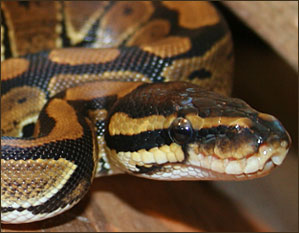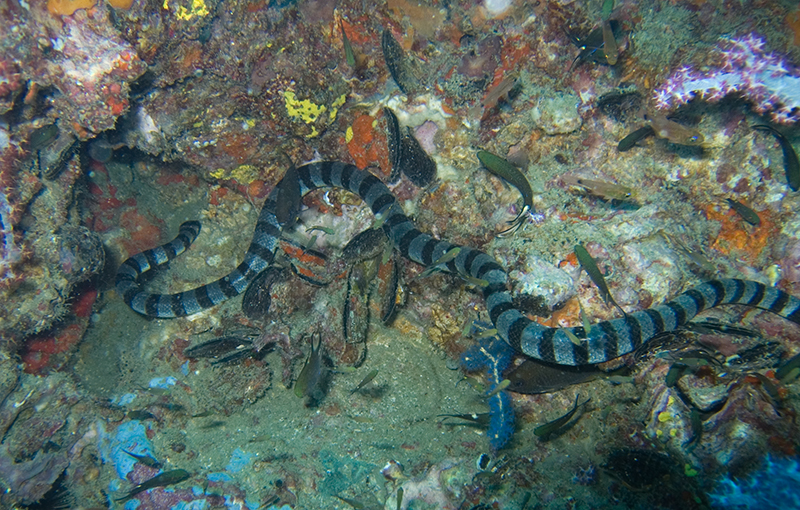Ball Pythons in the Wild
 As recently as the early 1990’s, the now popular ball python was considered a troublesome captive, due largely to the prevalence of wild caught adults in the trade. Today it is widely bred in captivity, but certain of its natural traits continue to affect how we go about keeping it as a pet. We’ll take a look at some of those traits, and then go on to captive care in future articles.
As recently as the early 1990’s, the now popular ball python was considered a troublesome captive, due largely to the prevalence of wild caught adults in the trade. Today it is widely bred in captivity, but certain of its natural traits continue to affect how we go about keeping it as a pet. We’ll take a look at some of those traits, and then go on to captive care in future articles.
Physical Description
Although small as far as pythons, go, this species is very thickly-built. Ball pythons average 3-5 feet in length, with occasional (and now only rarely encountered) specimens reaching 6 and even nearly 7 feet. It is the smallest African representative of the genus Python, but not the smallest African python per se. That title goes to the West African burrowing python, Calabaria reinhardtii, which rarely exceeds 3 feet in length.
Ball pythons are dark brown to nearly black in color and marked with numerous, generally oblong blotches of tan, light brown, reddish-brown or yellow-orange. The color of wild specimens varies tremendously among different populations, with pied and even albino individuals reportedly being encountered more frequently than is usual among other snake species. This may account for the ease in which captive color morphs are produced, although incubation temperature seems to affect the color pattern as well. The savannahs of Ghana are known for their predominance of yellow-orange ball pythons, which are much favored in the pet trade.
Range
Sub-Saharan Africa, from Senegal on the west coast northeast through Mali to western Sudan and southeast through Guinea-Bissau to the Gulf of Guinea, then east to the Central African republic, possibly Zaire, and Uganda.
Although typically described as being native to “Tropical West Africa”, the ball python actually has a fairly wide distribution across central and into parts of east Africa. In addition to the aforementioned countries, ball pythons have been recorded from Niger, Chad, Guinea, Sierra Leone, Liberia, Ivory Coast, Ghana, Togo, Burkina Faso, Nigeria, Benin and Cameroon.
Most of the parent stock of today’s captive population apparently originated in Toga and Ghana.
Habitat
Ball pythons are snakes of open, often arid habitats – savannahs and other grasslands, sparsely forested woodlands, overgrown fields and the borders of agricultural areas. They typically shelter in mammal burrows, termite mounds or hollow logs. Although largely terrestrial in some habitats, ball pythons will climb, and often occupy tree hollows where such are available.
Where undisturbed, they frequent barns, tilled fields and village outskirts, drawn by large rodent populations. Ball pythons do not occur in forests or thickly-wooded habitats, but will colonize such areas when they are cleared for agricultural use.
Status in the Wild
 This species is threatened across large areas of its range by collection for the food, leather and, in the past, pet trade. Today the vast majority of animals in the pet trade are captive bred. It is listed on Appendix II of Cites.
This species is threatened across large areas of its range by collection for the food, leather and, in the past, pet trade. Today the vast majority of animals in the pet trade are captive bred. It is listed on Appendix II of Cites.
Diet
Grassland rodents comprise the majority of the diet. Recorded prey species include cane rats, Nile rats, gerbils, jerboas, jirds and zebra mice. They also feed upon shrews and ground-nesting birds, and hatchlings may take lizards. Wild individuals often favor particular prey species, and may be difficult to habituate to commercially available rats and mice when taken captive.
Ball pythons often inhabit areas subject to long periods of hot, dry weather, during which food is scarce. Animals in such populations may aestivate in mammal burrows or similar underground shelters for several months. It is theorized that the internal circadian rhythms of these pythons may be responsible for the long fasts that captive animals often undergo.
Reproduction
Females produce typically 6-7 large eggs at yearly or less frequent intervals. Eggs are typically laid in abandoned aardvark or rodent burrows, and hatch after an incubation period of 3 months. In common with other family members, female ball pythons remain coiled about the eggs during this time, providing protection and temperature/humidity modification.
Female pythons of various species have been shown to actively raise the temperature of their clutch by coiling about the eggs and “shivering”. In captive situations, I have observed incubating female blood pythons (Python curtus) and Burmese pythons (P. molurus bivittatus) to raise their eggs by 7F above the ambient air temperature. Field research conducted with ball pythons, however, indicates that incubation mainly functions to conserve egg weight by preventing water loss.
The young measure 10-17 inches upon hatching, and reach sexual maturity at 3-4 years of age, by which time they are approximately 3 feet in length.
Economic Importance
Ball pythons are heavily utilized as food by people throughout much of their range, and are harvested for the leather trade as well. Until captive bred stock became widely available, huge numbers were collected for the pet trade and exported to Europe, Japan and the USA.
Miscellaneous
 The common name of this snake is derived from its habit of coiling into a tight ball, with the head hidden within the center, when threatened. Once so situated, it is difficult to uncoil the snake, and it will remain so even if rolled about (not recommended!). However, some ball pythons surprise attackers (and annoying keepers!) by biting savagely when disturbed. Actually, a number of other pythons and unrelated snakes utilize a coiled defensive posture, but in none is it so well developed as the ball python.
The common name of this snake is derived from its habit of coiling into a tight ball, with the head hidden within the center, when threatened. Once so situated, it is difficult to uncoil the snake, and it will remain so even if rolled about (not recommended!). However, some ball pythons surprise attackers (and annoying keepers!) by biting savagely when disturbed. Actually, a number of other pythons and unrelated snakes utilize a coiled defensive posture, but in none is it so well developed as the ball python.
An extensive CITES-generated study of ball python populations and management in Ghana is posted at:
http://www.stevegorzulapresents.com/study_royal_python_ghana.pdf
 There is only one reasonably reliable account of a modern-day snake measuring over 30 feet in length. A reward offered by the Bronx Zoo for another stood uncollected for nearly 100 years.
There is only one reasonably reliable account of a modern-day snake measuring over 30 feet in length. A reward offered by the Bronx Zoo for another stood uncollected for nearly 100 years. anaconda that I came up with was just over 17 feet long and weighed in at 215 pounds – no Titanoboa, but then again not an easy animal to wrest from the muck of a Venezuelan swamp either. For the full story and some photos of myself and others with that snake, please see my article Hunting Anacondas in the Venezuelan Llanos.
anaconda that I came up with was just over 17 feet long and weighed in at 215 pounds – no Titanoboa, but then again not an easy animal to wrest from the muck of a Venezuelan swamp either. For the full story and some photos of myself and others with that snake, please see my article Hunting Anacondas in the Venezuelan Llanos. That Reptile Blog – Reptile, Amphibian and Exotic Pet Care and Information
That Reptile Blog – Reptile, Amphibian and Exotic Pet Care and Information

 This species is threatened across large areas of its range by collection for the food, leather and, in the past, pet trade. Today the vast majority of animals in the pet trade are captive bred. It is listed on Appendix II of Cites.
This species is threatened across large areas of its range by collection for the food, leather and, in the past, pet trade. Today the vast majority of animals in the pet trade are captive bred. It is listed on Appendix II of Cites. The common name of this snake is derived from its habit of coiling into a tight ball, with the head hidden within the center, when threatened. Once so situated, it is difficult to uncoil the snake, and it will remain so even if rolled about (not recommended!). However, some ball pythons surprise attackers (and annoying keepers!) by biting savagely when disturbed. Actually, a number of other pythons and unrelated snakes utilize a coiled defensive posture, but in none is it so well developed as the ball python.
The common name of this snake is derived from its habit of coiling into a tight ball, with the head hidden within the center, when threatened. Once so situated, it is difficult to uncoil the snake, and it will remain so even if rolled about (not recommended!). However, some ball pythons surprise attackers (and annoying keepers!) by biting savagely when disturbed. Actually, a number of other pythons and unrelated snakes utilize a coiled defensive posture, but in none is it so well developed as the ball python. As recently as the early 1990’s, the now popular ball python was considered a troublesome captive, due largely to the prevalence of wild caught adults in the trade. Today it is widely bred in captivity, but certain of its natural traits continue to affect how we go about keeping it as a pet. We’ll take a look at some of those traits, and then go on to captive care in future articles.
As recently as the early 1990’s, the now popular ball python was considered a troublesome captive, due largely to the prevalence of wild caught adults in the trade. Today it is widely bred in captivity, but certain of its natural traits continue to affect how we go about keeping it as a pet. We’ll take a look at some of those traits, and then go on to captive care in future articles. Research focusing on the black-banded sea krait (Laticauda semifasciata) showed that the snakes obtain all their drinking water from fresh water springs (sea kraits leave the water on occasion), and refuse to drink sea water even when dehydrated. The majority of other sea snakes, which do not travel overland, are presumed to drink from the surface layer of fresh water that develops on the ocean when it rains. Indeed, sea snakes reach their greatest diversity in regions with heavy rainfall, and sea kraits are most common near fresh water spring outflows.
Research focusing on the black-banded sea krait (Laticauda semifasciata) showed that the snakes obtain all their drinking water from fresh water springs (sea kraits leave the water on occasion), and refuse to drink sea water even when dehydrated. The majority of other sea snakes, which do not travel overland, are presumed to drink from the surface layer of fresh water that develops on the ocean when it rains. Indeed, sea snakes reach their greatest diversity in regions with heavy rainfall, and sea kraits are most common near fresh water spring outflows.